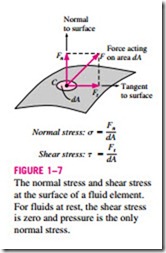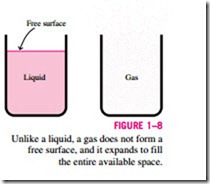FLUID MECHANICS
Mechanics is the oldest physical science that deals with both stationary and moving bodies under the influence of forces. The branch of mechanics that deals with bodies at rest is called statics while the branch that deals with bod- ies in motion is called dynamics. The subcategory fluid mechanics is defined as the science that deals with the behavior of fluids at rest (fluid statics) or in motion (fluid dynamics), and the interaction of fluids with solids or other flu- ids at the boundaries. Fluid mechanics is also referred to as fluid dynamics by considering fluids at rest as a special case of motion with zero velocity.
Fluid mechanics itself is also divided into several categories. The study of the motion of fluids that are practically incompressible (such as liquids, especially water, and gases at low speeds) is usually referred to as hydro- dynamics. A subcategory of hydrodynamics is hydraulics, which deals with liquid flows in pipes and open channels. Gas dynamics deals with flow of flu- ids that undergo significant density changes, such as the flow of gases through nozzles at high speeds. The category aerodynamics deals with the flow of gases (especially air) over bodies such as aircraft, rockets, and automobiles at high or low speeds. Some other specialized categories such as meteorology, oceanography, and hydrology deal with naturally occurring flows.
You will recall from physics that a substance exists in three primary phases: solid, liquid, and gas. A substance in the liquid or gas phase is referred to as a fluid. Distinction between a solid and a fluid is made on the basis of their abil- ity to resist an applied shear (or tangential) stress that tends to change the shape of the substance. A solid can resist an applied shear stress by deforming, whereas a fluid deforms continuously under the influence of shear stress, no matter how small. You may recall from statics that stress is defined as force per unit area, and is determined by dividing the force by the area upon which it acts. The normal component of a force acting on a surface per unit area is The normal stress and shear stress at the surface of a fluid element. For fluids at rest, the shear stress is zero and pressure is the only normal stress.
called the normal stress, and the tangential component of a force acting on a surface per unit area is called shear stress (Fig. 1–7). In a fluid at rest, the normal stress is called pressure. The supporting walls of a fluid eliminate shear stress, and thus a fluid at rest is at a state of zero shear stress. When the walls are removed or a liquid container is tilted, a shear develops and the liquid splashes or moves to attain a horizontal free surface.
In a liquid, chunks of piled-up molecules can move relative to each other, but the volume remains relatively constant because of the strong cohesive forces between the molecules. As a result, a liquid takes the shape of the con- tainer it is in, and it forms a free surface in a larger container in a gravitational field. A gas, on the other hand, does not have a definite volume and it expands until it encounters the walls of the container and fills the entire available space. This is because the gas molecules are widely spaced, and the cohesive
forces between them are very small. Unlike liquids, gases cannot form a free surface (Fig. 1–8).
Although solids and fluids are easily distinguished in most cases, this distinction is not so clear in some borderline cases. For example, asphalt appears and behaves as a solid since it resists shear stress for short periods of time. But it deforms slowly and behaves like a fluid when these forces are exerted for extended periods of time. Some plastics, lead, and slurry mixtures exhibit similar behavior. Such blurry cases are beyond the scope of this text. The fluids we will deal with in this text will be clearly recognizable as fluids.

